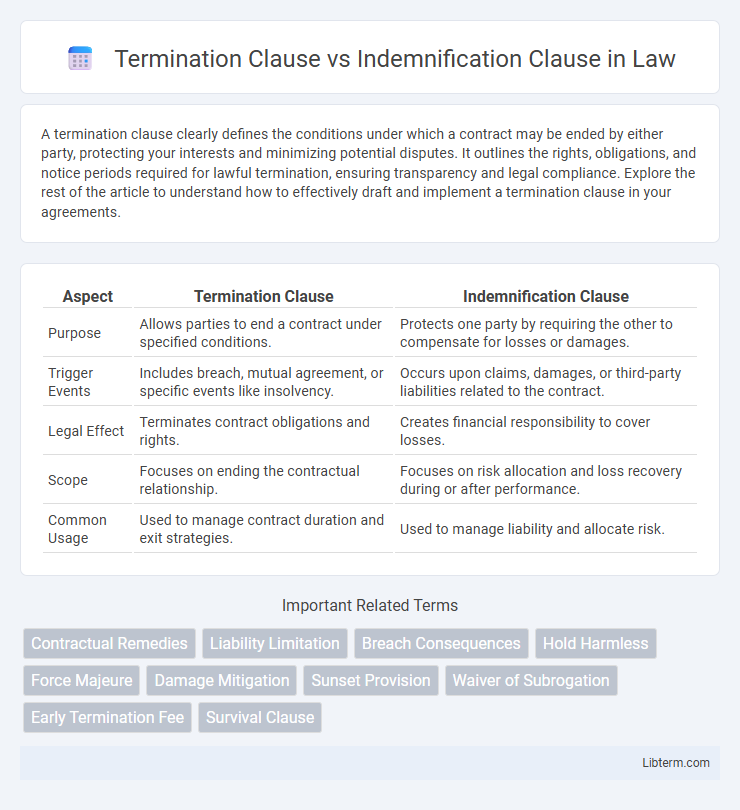A termination clause clearly defines the conditions under which a contract may be ended by either party, protecting your interests and minimizing potential disputes. It outlines the rights, obligations, and notice periods required for lawful termination, ensuring transparency and legal compliance. Explore the rest of the article to understand how to effectively draft and implement a termination clause in your agreements.
Table of Comparison
| Aspect | Termination Clause | Indemnification Clause |
|---|---|---|
| Purpose | Allows parties to end a contract under specified conditions. | Protects one party by requiring the other to compensate for losses or damages. |
| Trigger Events | Includes breach, mutual agreement, or specific events like insolvency. | Occurs upon claims, damages, or third-party liabilities related to the contract. |
| Legal Effect | Terminates contract obligations and rights. | Creates financial responsibility to cover losses. |
| Scope | Focuses on ending the contractual relationship. | Focuses on risk allocation and loss recovery during or after performance. |
| Common Usage | Used to manage contract duration and exit strategies. | Used to manage liability and allocate risk. |
Understanding Termination Clauses
Termination clauses specify the conditions under which a contract can be ended by either party, outlining notice periods, reasons for termination, and any obligations that survive termination. These clauses protect parties from prolonged liabilities and ensure clear exit strategies, minimizing disputes during contract dissolution. Understanding termination clauses is essential for managing contractual risks and maintaining control over the agreement's duration and cessation terms.
Key Elements of Indemnification Clauses
Indemnification clauses primarily establish the obligation of one party to compensate the other for specific losses, damages, or liabilities arising from defined events such as breaches, negligence, or third-party claims. Key elements include the scope of indemnity, the triggering events, the duration of the indemnification duty, and any limitations or exclusions on indemnity coverage. Unlike termination clauses that outline conditions for ending agreements, indemnification clauses focus on risk allocation and financial protection between contracting parties.
Purpose and Importance: Termination vs Indemnification
A Termination Clause outlines the conditions under which parties can end a contract, providing clear guidelines to prevent disputes and ensure smooth contract dissolution. An Indemnification Clause allocates risk by requiring one party to compensate the other for specific losses or damages, protecting parties from unforeseen liabilities. Understanding the distinct purposes of termination and indemnification clauses is crucial for effective contract risk management and legal protection.
Common Scenarios Triggering Termination
Common scenarios triggering a termination clause include breach of contract, failure to meet performance milestones, and insolvency of a party. Indemnification clauses, however, primarily address liability and financial responsibility for damages, rather than ending the agreement. Termination clauses ensure contract cessation under predefined conditions, while indemnification clauses protect parties from specific losses or claims arising during the contract's lifespan.
Types of Indemnification Provisions
Indemnification provisions include types such as general indemnity, where one party agrees to cover broader liabilities, and limited indemnity, restricting responsibility to specific damages or claims. Specific indemnification clauses may cover third-party claims, breach of contract, or intellectual property infringements, each tailored to allocate risk precisely. Understanding these types aids in negotiating termination clauses by clarifying financial protections and liability exposures upon contract end.
Legal Risks of Poorly Drafted Clauses
Poorly drafted termination clauses can create significant legal risks, including unclear grounds for ending the contract, which may lead to disputes, unintended contract extension, or financial penalties. Inadequate indemnification clauses increase exposure to liability by failing to clearly define the scope, limits, and conditions under which one party compensates the other for losses or damages. Precise drafting of both termination and indemnification clauses is essential to mitigate contractual ambiguities, reduce litigation risks, and protect parties from unforeseen financial burdens.
Negotiating Favorable Termination Terms
Negotiating favorable termination terms requires a clear distinction between the termination clause and the indemnification clause, as the former governs the conditions under which a contract may be ended, while the latter addresses compensation for losses or damages resulting from breaches or specific events. Emphasizing precise language around termination triggers, notice periods, and consequences can limit exposure to abrupt contract ends and ensure adequate protection through indemnification provisions. Incorporating defined limits on liability and specific carve-outs within indemnification clauses supports balanced risk allocation and strengthens overall negotiation outcomes.
Limiting Liability Through Indemnification
Termination clauses define conditions under which contracts can be ended, while indemnification clauses allocate financial responsibility for losses or damages. Limiting liability through indemnification involves specifying caps on monetary obligations and excluding certain types of damages, protecting parties from excessive claims. Clear, detailed indemnification provisions reduce risk exposure more effectively than termination clauses alone.
Real-World Examples: Termination and Indemnity
Termination clauses in contracts define the conditions under which parties may end an agreement, often seen in service contracts where delays or breaches justify termination, such as a software development contract allowing termination if deliverables miss deadlines. Indemnification clauses allocate risk by requiring one party to compensate the other for specific losses or damages, exemplified by a construction contract where the contractor indemnifies the client against liability from accidents on site. Real-world scenarios highlight termination's role in mitigating ongoing obligations, while indemnification protects against financial harm arising from third-party claims or contractual breaches.
Best Practices for Drafting Contract Clauses
Clear and precise language is essential when drafting termination clauses to define conditions under which parties may end the contract without ambiguity, reducing potential disputes. Indemnification clauses must specifically delineate the scope of liability, including covered losses and responsible parties, ensuring enforceability and risk allocation. Incorporating jurisdiction-specific legal requirements and aligning clauses with overall contract objectives promotes balanced protection and operational clarity.
Termination Clause Infographic

 libterm.com
libterm.com